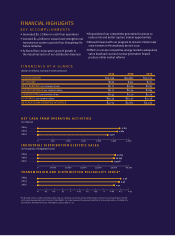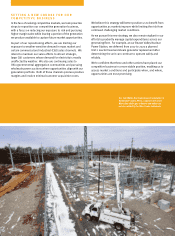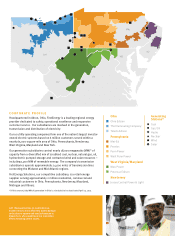Allegheny Power 2014 Annual Report Download - page 7
Download and view the complete annual report
Please find page 7 of the 2014 Allegheny Power annual report below. You can navigate through the pages in the report by either clicking on the pages listed below, or by using the keyword search tool below to find specific information within the annual report.
MEETING ENVIRONMENTAL
REQUIREMENTS
In June 2014, as part of its efforts to reduce U.S. greenhouse
gas emissions under the Clean Air Act, the U.S. Environmental
Protection Agency (EPA) proposed state-specific guidelines
for the regulation of carbon dioxide (CO2) from existing
power plants. Scheduled to be finalized in mid-summer
of this year, the EPA proposal – called the Clean Power
Plan – would provide guidance to the states for developing
implementation plans to reduce their power sector emission
rates. The EPA also separately proposed standards for
regulating carbon emissions from new, modified or
reconstructed power plants.
We’re concerned about a proposal that currently allows
only 6 percent of existing nuclear generation, which emits
no CO2, to count toward achieving emission reduction
targets. We also will monitor new details that emerge as the
regulatory process evolves and as state regulators design
their implementation plans.
While the EPA’s proposed carbon standards are being
challenged in the courts, we continue to make significant
progress in improving the environmental performance of our
generating fleet.
By adjusting the mix of our generating assets during the
past three years, we’re now operating a cleaner, more
efficient portfolio. In 2015, nearly 100 percent of the power
we produce is expected to come from low- or non-emitting
sources, including nuclear, scrubbed coal, natural gas and
renewable energy. Through these and other environmental
efforts, we are on track to achieve a 25 percent reduction
below 2005 levels of CO2 emissions this year.
We also are on target to exceed benchmarks established
by the EPA’s Mercury and Air Toxics Standards. As part
of this effort, we have identified several opportunities to
reduce compliance costs, and now expect to spend a total of
approximately $370 million on this effort.
LEADING THE CHARGE FOR VITAL
MARKET REFORMS
We actively support efforts to ensure competitive energy
markets adequately value baseload coal and nuclear plants,
which are essential to maintaining grid reliability. These
efforts helped produce initial market reforms supporting price
stability and service reliability for our customers.
Extreme weather events, including record low temperatures in
January 2014, resulted in power price volatility, underscoring
the implications of our region’s growing dependence on
less-reliable resources. These include natural gas, which is
challenged by supply system constraints; demand response,
which depends on customers curtailing their electricity
consumption during peak periods; and intermittent renewables.
We’re encouraged by a Capacity Performance product
developed by our regional transmission organization,
PJM Interconnection, to recognize the value of baseload
generation. The product is a step in the right direction and
may provide additional revenue to generating resources
that have onsite fuel storage, a high degree of availability
and operational flexibility. We will continue to work closely
with PJM to improve the proposal, as well as to pursue other
efforts that recognize the value of a diverse and dependable
generating fleet.
5
Top Right: Projects underway at our Fort Martin Power Station in
Maidsville, W.Va., are designed to enhance the plant’s performance
and prepare it to meet new environmental requirements.
Lower Right: This environmental control equipment is part of a $1.8 billion
retrofit completed in 2010 at our W.H. Sammis Plant in Stratton, Ohio.




















